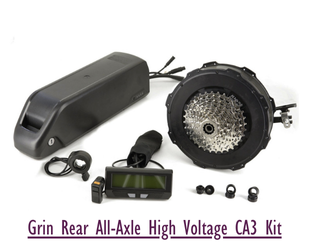E-Conversions Kits
 |
| Factory Made E-Bike By Marin Bikes: Sausalito E2 |
All e-bikes have the same basic components: a motor, a battery, and controls. However, some ebikes have these parts integrated into a bike’s design and some are standard bikes that have had them added post-purchase. The first kind is called a “factory-made” or “purpose-built” ebike, the second is a “e-conversion.”
Standard bikes are made to be propelled by the human body. You can add a motor later, but the original bike was built to be person-powered. Likewise, you can ride a factory-made ebike with pedal power alone, but it’s fundamentally a motorized vehicle. If you’ve ever wondered why factory-made e-bikes look so different from standard bicycles, this is why.
Being light, ergonomic, and efficient—very important factors in standard bikes—matter much less for a purpose-built ebike. Instead, priority goes to having a frame that’s big enough to house the motor and battery and beefy enough to handle the dynamic forces of riding a faster, heavier bike. From a manufacturing perspective, the easiest way to check those boxes is to overbuild the frame. Thick, heavy tubing and inefficient geometry might be drawbacks for person-powered bikes, but they’re less of a problem when there’s a motor in the mix. As a result, these bikes are often cumbersome to ride without the e-assist—as anyone who’s battery has died mid-ride can tell you!
 |
| Bombtrack bike with e-kit: Mid-drive motor and 52V system from Tongsheng feat a HUGE 750wh battery |
One thing we like about e-conversions is that you can get the best of both worlds: electric assistance when you need it, on a bike that still rides the way you want. Adding an e-kit will make your bike heavier, but it won’t change its basic design. And many—though not all—standard bicycles are strong enough to handle both the extra weight and increased force that come with motorization.
REASONS TO CHOOSE AN E-CONVERSION
Conversion kits allow you to dial in the “e” aspects such as:
- battery range
- torque
- throttle vs. pedal-assist
- torque sensor vs. cadence sensor
- mid drive vs. hub drive
- integrated lights
- add-ons like a charger for your personal electronics or even solar panels to power your bike!)
Converting a standard bike with an e-kit also means you get to choose the bike itself. Any good quality bike can be converted, which means a much wider range of styles, features, and sizes to choose from. Last but not least, a converted e-bike can always be turned back into a standard bike, should you ever want to go back to basics.
You Already Have A Great Bike, But Need A Boost
Many cyclists opt for e-kit conversions because it means you can keep your beloved steed and ride further, faster, and with greater ease. It may be that your commute has gotten longer and hillier, that you just started your CSA delivery business, have your heart set on reaching remoter bikepacking spots, or that your body has changed but your verve for riding hasn’t!Remember when you could just pop a new battery into your tired iPod and give it a new lease on life? We’re all misty-eyed for those days. Unfortunately, like many other consumer electronics, factory e-bikes are increasingly made with corporate interests ahead of customers’.
Factory e–bikes tend to be built for fairly casual riders and folks who aren’t hauling much more than a couple of panniers. That means that their power and range won’t be up to every kind of riding.
You Want To Streamline Ebike Life
REASONS TO CHOOSE FACTORY-MADE
You’re On A Budget
You Need A Simple Ebike
Every e-conversion is a custom job. That’s one of the strengths of a conversion over a factory-made ebike, but it can also come with complications.
Unlike factory-made ebikes that are carbon copies of a road-tested prototype, a conversion may need some fine-tuning at first. Visits to the bike shop for e-system troubleshooting and a bit of a learning curve on your part are normal parts of a conversion. But once we iron out any kinks and you get to know the system a bit, it should be smooth sailing.















Comments
Post a Comment